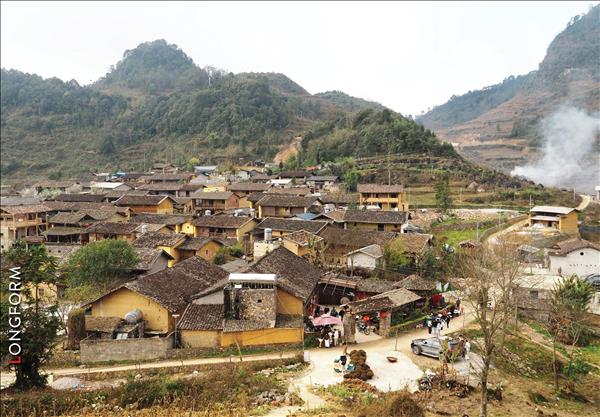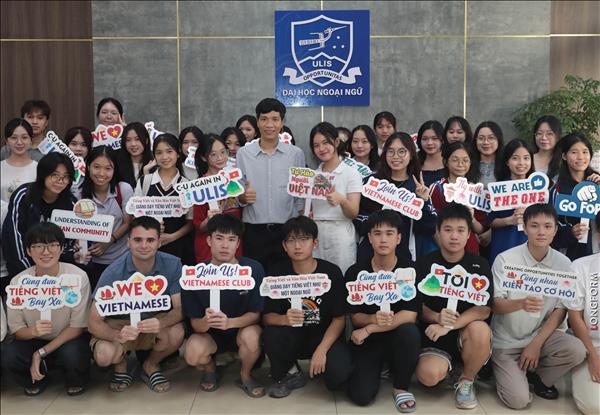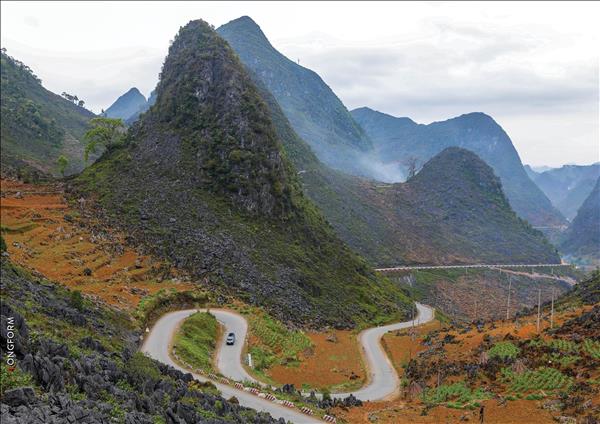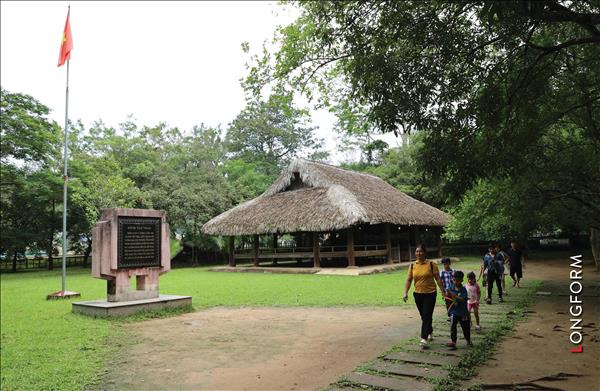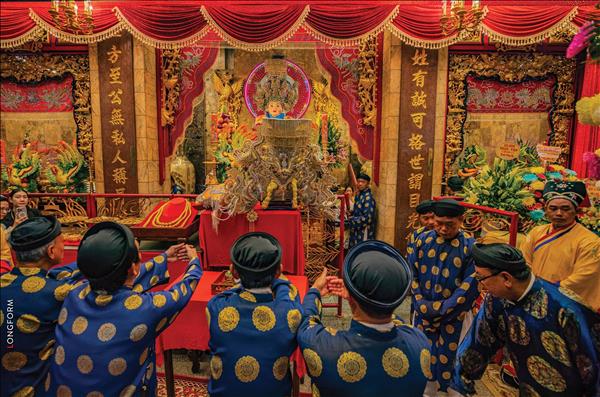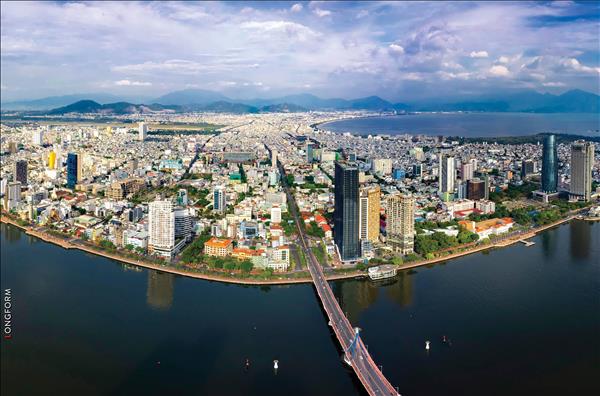After 130 years, Vietnam now has a railway network with a total length of 3,160 km connecting residential areas and agricultural, industrial and cultural hubs from the North to the South. Low costs, high safety, energy and resource efficient and environmentally friendly are among the advantages of rail transport.
Train wheels for doi moi
Seeing Vietnam’s geographical advantage of having a coast running from north to south, in 1936, French colonists built a railway system with a total length of 2,600 km in the country.
During the war, the north-south rail route was dividedand restored only after the country was reunified in 1975.
Vietnam’s railway sector had accomplished its historical missions in the two great wars for national defense and is now carrying the important missions of tourism promotion and cargo transport.
For generations of Vietnamese, whenever they hear the song “My train passes through the mountains” by famous composer Phan Lac Hoa, they have an indescribable feeling of pride for their charming country. The song is a storytold by a train driver to his lover, praising the beauty of his homeland with such beautiful verses as “Passing the Hai Van pass, seeing the clouds flying on the mountain peak”, “The homeland’s sea is calm with soft sand”, “My train passes over high mountains”.
Going by train in Vietnam, a country shaped like the letter S with a coast running from north to south, one will have a chance to see yellow rice fields in harvest time, green orchards, clear and blue water, gentle rivers and grand mountains, associated with popular tourist destinations. These places include Ham Rong in Thanh Hoa province, Ben Thuy in Nghe An province, Ngang pass which lies between the central provinces of Ha Tinh and Quang Binh, Lang Co in Thua Thien-Hue province, Hai Van pass which lies in the middle of Thua Thien Hue and Da Nang, Ca Na beach in NinhThuan province and Dien cape in Phu Yen province.
From Hanoi station, with Choloe Maxwel and other Australian companions, we chose the Thong Nhat night train to reach Da Nang. Maxwell opted for this train since this route is ranked by the Daily Telegraph as one of the ten most impressive tourist train routes in the world.
Early the next morning, Maxwel and her friends were stunned by the beauty of the scenery on Hai Van pass when our train arrived at Lang Co beach in ThuaThien Hue, the South East Asia’s largest lagoon. Maxwel was excited to see Da Nang, which is close to numerous tourist attractions, including world heritages Hoi An town and My Son sanctuary.
On another journey, we and the family of Vo Dinh Khang were on a SaiGon-NhaTrang five-star train. Khang was so pleased with the trip because his children had a really good time travelling bytrain with luxury services on this route.
The railway sector is reporting a steadily rising number of train passengers, given its efforts to lower ticket prices, improve the quality of service and introduce five-star train services, according to Dao Anh Tuan, General Director of the Saigon Railway Transport Joint Stock Company.
The sector has opened short- and medium-distance routes to tourist destinations such as Hanoi-Lao Cai, Hanoi-Da Nang, Saigon-PhanThiet and Saigon-NhaTrang, which have increasingly attracted tourists. The train service to NhaTrang, for instance, at times, has nearly 2,000 seats booked for each train.
Rolling train wheels
Trains named Thong nhat (renuification) running through the country from north to south symbolize Vietnam’s desire for renewal in each period of national development.
In the two wars of national defense, every train carried the whole nation’s aspiration for reunification, taking people and cargo from the North to support the southern battlefield, making major contributions to the national victory in 1975. Today, trains are running around the clock for national construction.
Under the strategy for transport service developmentto 2020, with orientations towards 2030, approved by the Prime Minister recently, railway and inland waterway transport will be prioritized while road transport will be reduced. The railway sector is thus renewing its physical foundations, equipment, facilities and technology to meet this requirement.
The railway sector now has over 5,000 cargocompartments and nearly 300 locomotives. It is also applying advanced technology to operate trains to raise the transport capacity. The industry’s cargo capacity now reaches seven million tonnes annually.
According to Mr Vu Anh Minh, Chairman of the Members’ Council of Vietnam Railways, the railway sector is improving its services to best serve passengers, such as collaborating with other transport service providers to offer package cargo transport services from places of departure to places of destination in a safe and timely manner.
While increasing shares of the domestic transport market, the sector is operating transnational routes such as the Vietnam-China international container transport route. Do Van Hoan, deputy general director of the Hanoi Railway Transport Joint Stock Company said the international container transport opens a development potential for the railway sector, citing transnational-transported freights have risen from 386,000 tonnes in 2016 to 800,000 tonnes in 2017.
The sector is modernising two key cargo stations of Yen Vien in Hanoi and Song Than in Binh Duong province to cater to the increasing demand for international rail transport.
During the war, the north-south rail route was dividedand restored only after the country was reunified in 1975.
|
“If we consider travelling by train is like reading a book, it no longer means going from A to B but “reading” the landscapes, people and culture” Oep Janssen, a Dutch tourist, shares his feelings on a seven-day trip with his family on Vietnam’s rail services Source: the Tuoi Tre (Youth) daily |
For generations of Vietnamese, whenever they hear the song “My train passes through the mountains” by famous composer Phan Lac Hoa, they have an indescribable feeling of pride for their charming country. The song is a storytold by a train driver to his lover, praising the beauty of his homeland with such beautiful verses as “Passing the Hai Van pass, seeing the clouds flying on the mountain peak”, “The homeland’s sea is calm with soft sand”, “My train passes over high mountains”.
Going by train in Vietnam, a country shaped like the letter S with a coast running from north to south, one will have a chance to see yellow rice fields in harvest time, green orchards, clear and blue water, gentle rivers and grand mountains, associated with popular tourist destinations. These places include Ham Rong in Thanh Hoa province, Ben Thuy in Nghe An province, Ngang pass which lies between the central provinces of Ha Tinh and Quang Binh, Lang Co in Thua Thien-Hue province, Hai Van pass which lies in the middle of Thua Thien Hue and Da Nang, Ca Na beach in NinhThuan province and Dien cape in Phu Yen province.
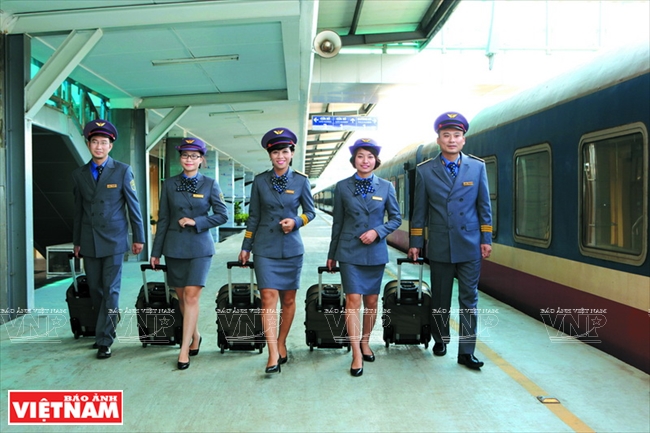 Train drivers and on board service staff. Photo: Files 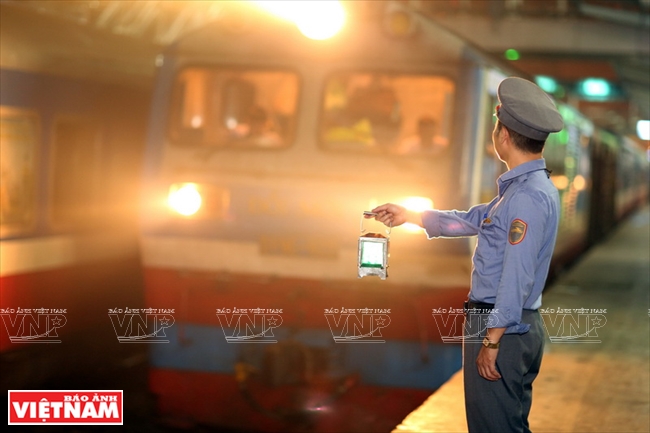 Signaling safety for a train to depart. Photo: Tat Son / VNP 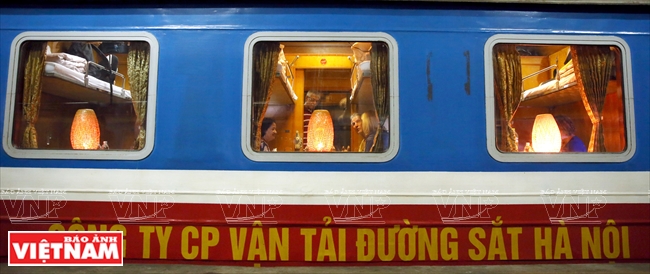 A north-south tourist train of the Hanoi Railway Joint Stock Company at Hanoi station. Photo: Tat Son/VNP  Vo Duc Ky, conductor-in-chief of Hanoi - Ho Chi Minh City Train SE3, with a little passenger. Photo: Tat Son / VNP 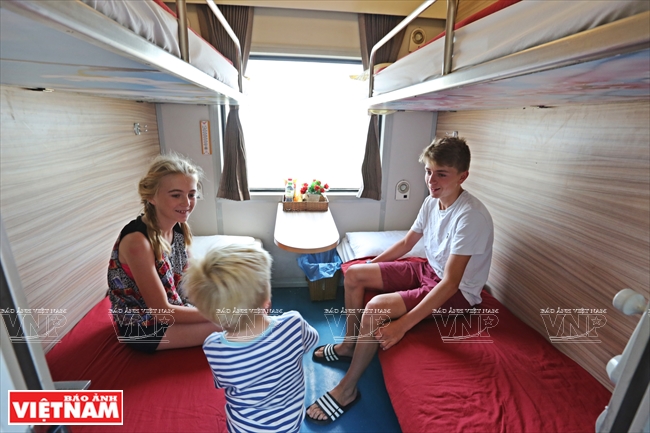 Comfortable space inside a carriage. Photo: Tat Son/VNP 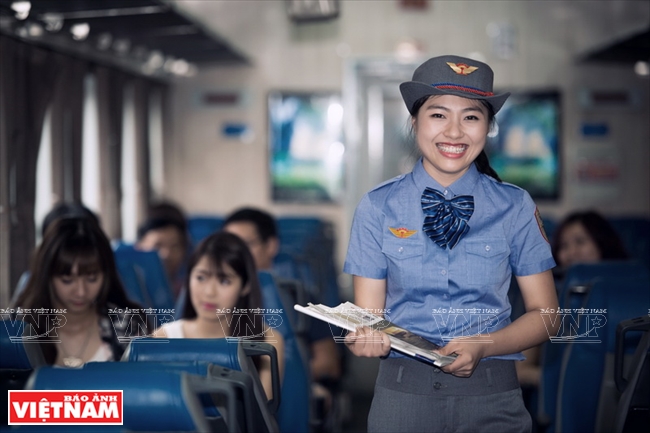 Distributing free newspapers to passengers on board. Photo: Files 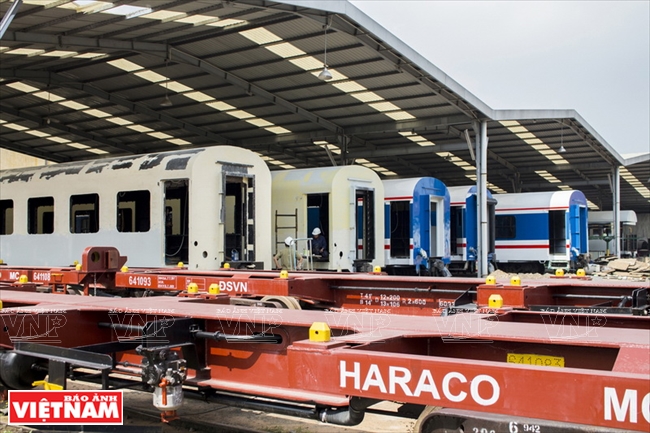 Di An Train Joint Stock Company which designs and manufactures passenger compartments. Photo: Thong Hai / VNP 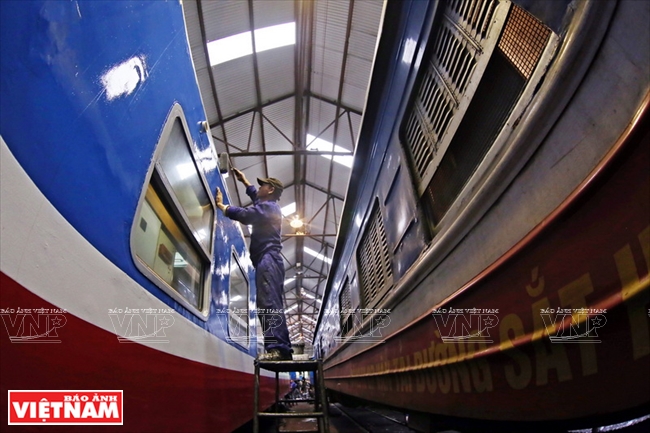 At Hanoi compartment branch under the Hanoi Railway Joint Stock Company where compartments are repaired. Photo: Cong Dat / VNP 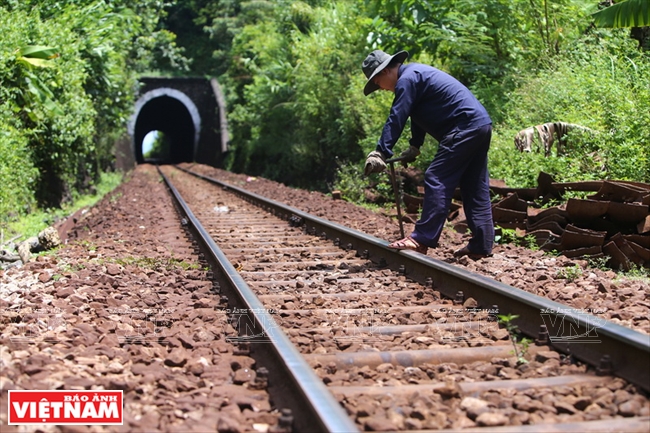 Checking the railway section on Hai Van pass in Da Nang. Photo: Cong Dat/VNP |
From Hanoi station, with Choloe Maxwel and other Australian companions, we chose the Thong Nhat night train to reach Da Nang. Maxwell opted for this train since this route is ranked by the Daily Telegraph as one of the ten most impressive tourist train routes in the world.
Early the next morning, Maxwel and her friends were stunned by the beauty of the scenery on Hai Van pass when our train arrived at Lang Co beach in ThuaThien Hue, the South East Asia’s largest lagoon. Maxwel was excited to see Da Nang, which is close to numerous tourist attractions, including world heritages Hoi An town and My Son sanctuary.
On another journey, we and the family of Vo Dinh Khang were on a SaiGon-NhaTrang five-star train. Khang was so pleased with the trip because his children had a really good time travelling bytrain with luxury services on this route.
The railway sector is reporting a steadily rising number of train passengers, given its efforts to lower ticket prices, improve the quality of service and introduce five-star train services, according to Dao Anh Tuan, General Director of the Saigon Railway Transport Joint Stock Company.
The sector has opened short- and medium-distance routes to tourist destinations such as Hanoi-Lao Cai, Hanoi-Da Nang, Saigon-PhanThiet and Saigon-NhaTrang, which have increasingly attracted tourists. The train service to NhaTrang, for instance, at times, has nearly 2,000 seats booked for each train.
Rolling train wheels
| Vietnam now has 3,160 km of railways, including 2,524 km of seven main routes: Hanoi – Ho Chi Minh City, Hanoi – Lao Cai, Hanoi – Haiphong, Hanoi – Dong Dang, Hanoi – Quan Trieu, Kep – Ha Long, Kep – Luu Xa. Each year, the trains carry nearly 12 million passengers. |
In the two wars of national defense, every train carried the whole nation’s aspiration for reunification, taking people and cargo from the North to support the southern battlefield, making major contributions to the national victory in 1975. Today, trains are running around the clock for national construction.
Under the strategy for transport service developmentto 2020, with orientations towards 2030, approved by the Prime Minister recently, railway and inland waterway transport will be prioritized while road transport will be reduced. The railway sector is thus renewing its physical foundations, equipment, facilities and technology to meet this requirement.
|
A Thong Nhat train runs through Vung Ro bay in Phu Yen province. Photo: Thong Hai / VNP A train is about to arrive Nha Trang station. Photo: Thong Hai / VNP  A Thong Nhat train runs through Hai Van pass in the middle of Da Nang and Thua Thien Hue province. Photo: Tat Son/VNP 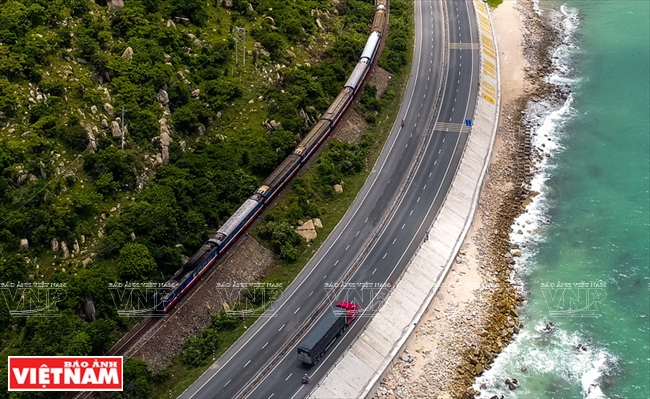 A North – South train running parallel to the national road at the section of Ca Na in Ninh Thuan province. Photo: Nguyen Luan/VNP 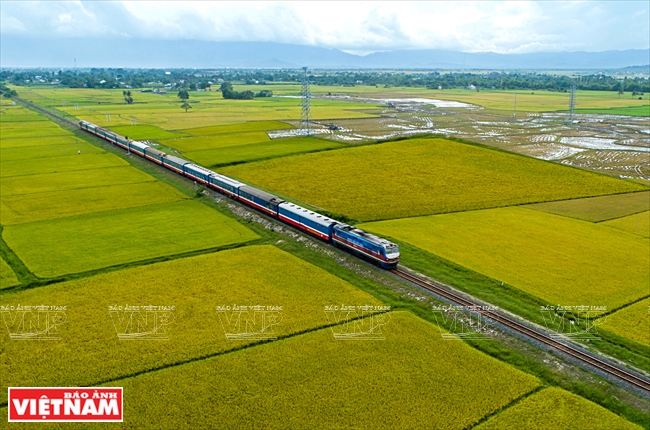 The north –south railway passes through beautiful rice fields. Photo: Thong Hai/VNP 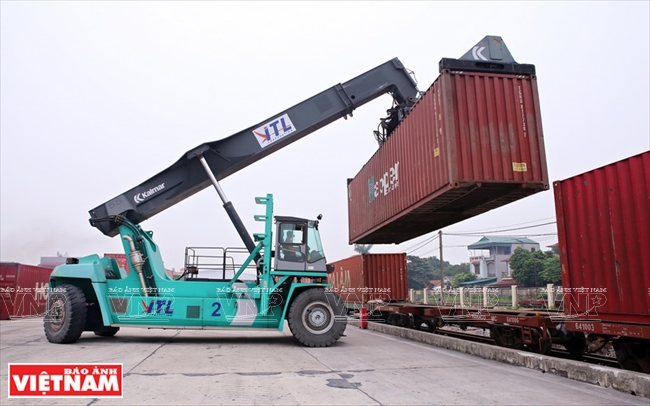 Vietnam and China welcomed the first container train at Dong Dang station in Vietnam’s Lang Son northern province on November 25, 2017. The first train connecting the two countries departed from Huanggang station, Nanchang city, Jiangxi province of China. Its final destination was Yen Vien station, Hanoi. |
|
“Rail container transport will be the first choice for clients in the two countries. Goods exported and imported between Vietnam and China and transited through third countriesare rising steadily,” a leader of Vietnam Railways said. Source: E-newspaper Vietnam Plus |
According to Mr Vu Anh Minh, Chairman of the Members’ Council of Vietnam Railways, the railway sector is improving its services to best serve passengers, such as collaborating with other transport service providers to offer package cargo transport services from places of departure to places of destination in a safe and timely manner.
While increasing shares of the domestic transport market, the sector is operating transnational routes such as the Vietnam-China international container transport route. Do Van Hoan, deputy general director of the Hanoi Railway Transport Joint Stock Company said the international container transport opens a development potential for the railway sector, citing transnational-transported freights have risen from 386,000 tonnes in 2016 to 800,000 tonnes in 2017.
The sector is modernising two key cargo stations of Yen Vien in Hanoi and Song Than in Binh Duong province to cater to the increasing demand for international rail transport.
|
The railway sector is set to raise the speed of passenger trains to 80-90 km/h, and cargo trains, to 50-60 km/h by 2020. The sector is expected to have express trains of 160-200 km/h by 2030 and high-speed trains of 350 km/h by 2050” |
Story: Nguyen Oanh
Photos: Tat Son, Cong Dat, Thong Hai, Nguyen Luan & Files
Photos: Tat Son, Cong Dat, Thong Hai, Nguyen Luan & Files

